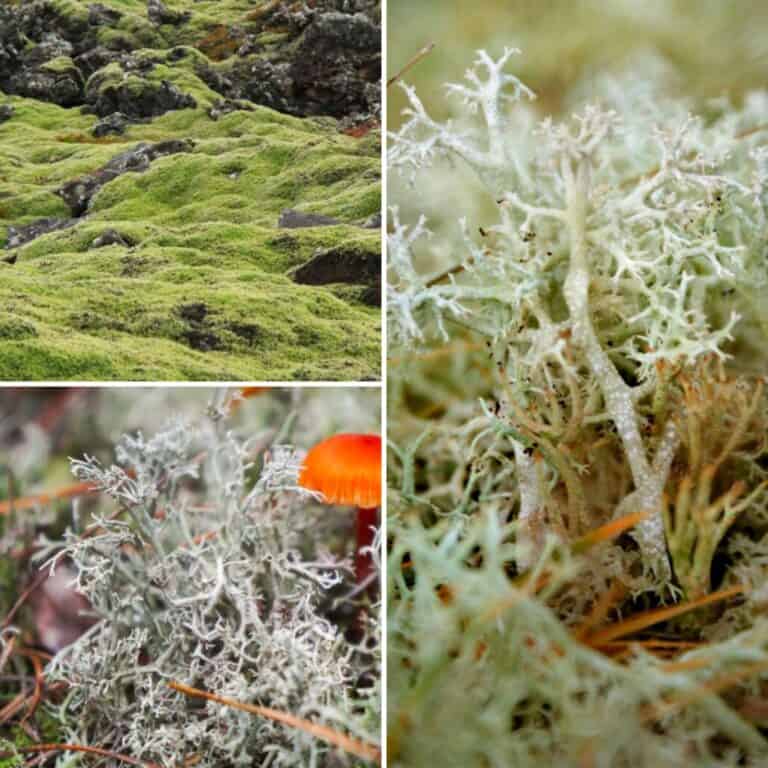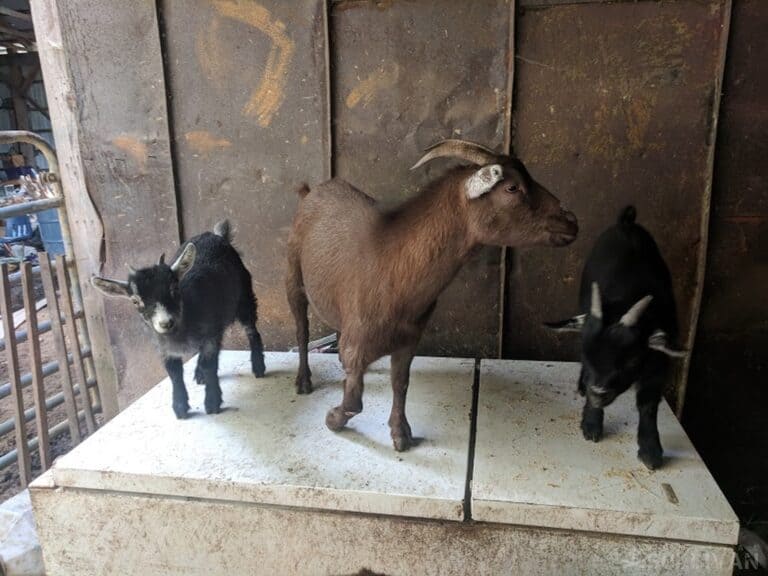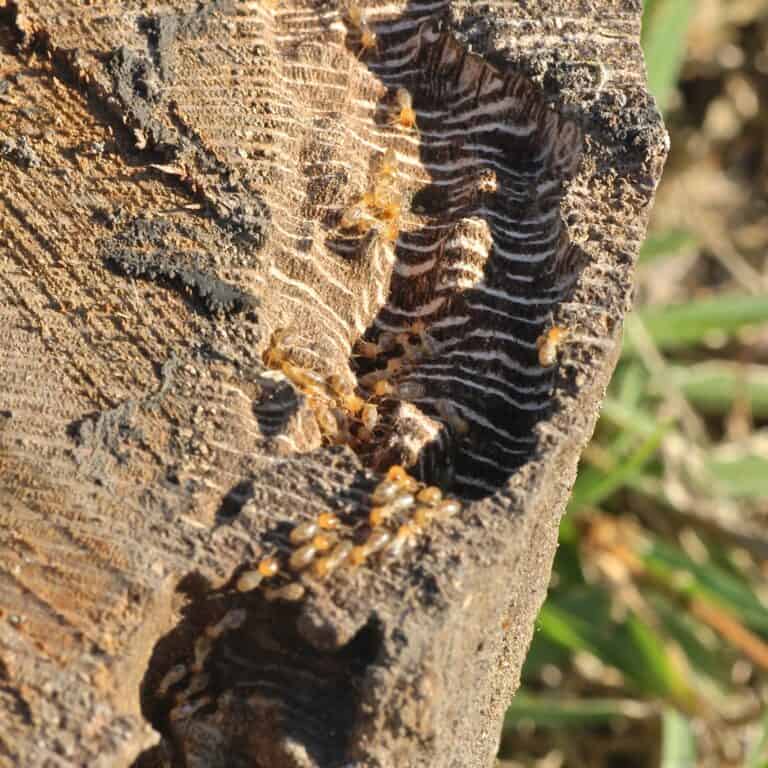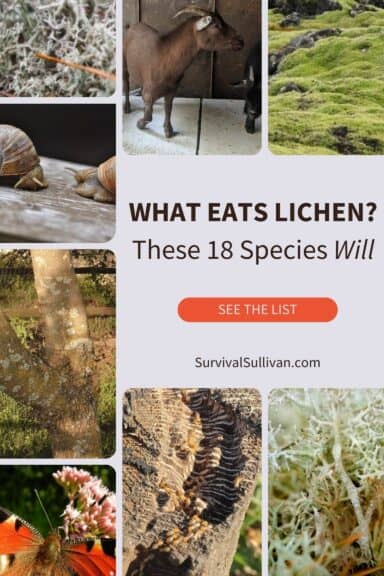If you’ve been anywhere out in nature, chances are you’ve seen lichen before. These strange, almost furry growths on rocks and trees are often mistaken for moss, fungus, or some other kind of plant life.

But lichen is actually a type of composite organism, onethat occurs when algae or certain kinds of bacteria grow among the living filaments of certain fungi species.
It’s fascinating and crazy stuff, and one element of nature that is truly remarkable. But what you really need to know, practically, is what kind of animals can eat lichen.
Knowing that might help you locate your own dinner when in the wild, or make an informed decision about what animal species are in the area. Keep reading, and I’ll tell you about 18 different animal species that feed on lichen.
Mammals
Reindeer /Caribou
Rangifer tarandus, known as Reindeer in Europe and Asia, or Caribous in North America, are adaptable and hardy deer. They have to be, since they inhabit Arctic tundra and boreal forests around the globe.
Owing to the harsh conditions they live in, they must partake of what nutrients they can get, when they can get them. These large deer are known for their migratory habits, covering vast distances in response to seasonal changes.
Their diet is accordingly quite diverse, and includes various mosses, herbs, ferns, grasses, and the shoots and leaves of shrubs and trees- most especially willow and birch.
But reindeer also eat lichen, and it forms an important link in their dietary chain since it will remain accessible when other foods are scarce or non-existent.
Among all the animals on our list, lichen is arguably the most important for reindeer as it is a staple of their diet at various times throughout the year.
Squirrels
Found all over the world, squirrels are a large family of rodents invariably known for their bushy tails, cute faces, and supreme climbing agility. As with most rodents, all have a diverse diet…
While they predominantly feed on nuts and seeds, some species do opportunistically eat lichen, particularly during the winter when other food sources are scarce, and their stored (and often lost) food can’t quite go the distance.
Voles
Voles are another kind of rodent. They are small, burrowing and invariably mistaken for their close relatives, mice, and rats, by folks who aren’t totally acquainted with these critters. But you can easily tell them apart by their longer and often hairy tails.
Though voles usually subsist on roots, tubers, and various kinds of plant bulbs, those native to colder regions include lichen on the menu. For those that are adapted to it, lichen provides them with various essential nutrients and a little protein during food-scarce winters.
Marmots
Marmots are technically members of the squirrel family, above, but occupy their own unique genus with more than 15 different species, including groundhogs.
Sometimes gregarious and sometimes solitary, these big, digging rodents are found in hilly and mountainous biomes all around the world, but predominantly in the northern hemisphere.
Marmots are strict herbivores, and they eat all kinds of greenery and plant matter, including many kinds of lichen. For species inhabiting the coldest places, like the Gray Marmot of Siberia, we once again see lichens as a staple food source.
Musk Oxen
Looking for all the world like a shaggy, bearded bison, Musk Oxen are made to endure incredibly frigid conditions.
Sporting impressively insulating thick and rough fur that reaches all the way to the ground, they graze on a wide variety of low or creeping vegetation like grasses, mosses and, of course, lichens.
Camels
Camels are the undisputed endurance champions of the animal kingdom; a good thing since they are native to some of the driest and harshest regions on the planet!
While lichens aren’t a fixture in their diet, camels must be resourceful to survive and so they will consume them when given an opportunity or when other food sources are hard to come by.
Lemmings
Popularly thought to have suicidal tendencies owing to their huge population migrations and, sometimes, attendant mass leaping from cliffs into bodies of water, lemmings are yet another small, lichen-eating rodent on our list.
Inhabiting some of Earth’s coldest reaches, once again, we see that lichens form an important resource for lemmings in these sometimes food-scarce places. Aside from lichens, lemmings like a vegetarian diet of leaves, shoots, berries, and roots.

Goats
Goats are best known for their wide-ranging diet and remarkable adaptability. Anyone who’s owned them for any length of time will also tell you they are truly rascals…
Anyways, though they cannot eat anything, despite the pop culture notion, as ruminants their four-chambered stomach does allow them to digest seemingly nutrient-deficient plant materials with ease.
As browsers, goats concern themselves with only the choicest bits of any given food source, and are often seen munching on tender grass, shrubs, and leaves.
But wild and domestic ones are also known to eat lichens from time to time, either as a supplemental item or food during times of scarcity.
Whether it’s a wild mountain goat navigating sheer cliffs or a domesticated farm goat grazing in a pasture, lichens play a limited but still important role in their diet.
Humans
It’s true: most kinds of lichen are edible by people with a little prep. While lichens might not typically feature in our everyday meals, they’ve been relied on as a survival food throughout history and are still consumed as a cultural dish in several countries today.
Lichens are eaten in soups and salads, as a garnish, or ground into a powder and used as or with flour. Certain types are even used in the brewing process for alcoholic beverages!
Human-safe and nominally nutritious kinds of lichen include reindeer moss, Iceland moss, and oakmoss.
But be cautious: not all lichens are safe to eat, some can be highly toxic and all need cooking to avoid an upset stomach. You must learn which ones are safely edible in your area before you rely on them in a survival situation!
Invertebrates
Slugs
Slugs are found in virtually all moist environments, and like most of the creatures on our list are known for their varied diet.
They’re not picky eaters and will consume all sorts of things, from leaves and rotting bark to fungi, and yes, lichens. Lichens offer slugs essential dietary nutrients that are easily digested.
Snails
A close but taxonomically distinct cousin to slugs, snails likewise enjoy a predominately vegetarian diet which includes lichens among many other things. Lichens help snails survive and thrive in all sorts of diverse habitats, ranging from forests to deserts.
Crabs
Believe it or not, crabs, the scuttling crustaceans of the sea, also partake in lichens every now and then when ashore. It should be noted, though, that they cannot be said to rely on them as a staple food source in any real way…
While they primarily feed on small fish, carcasses, and other maritime fodder, some species, especially the more terrestrially-inclined ones, have been observed delicately munching on lichens when other food sources are unavailable.
Insects

Termites
Termites are infamous for causing devastating structural damage to buildings, but their preference for decaying wood informs us of their other dietary preferences.
Termites have a varied diet primarily consisting of cellulose from wood, but some species have been found to consume lichens and other plant matter routinely.
Grasshoppers
A huge diversity of grasshoppers is found all over the world, and all enjoy a mostly plant-based diet. While ‘hoppers usually prefer to nibble various grasses and leaves, they’re not above including lichens in their diet.
Lichens are a good source of nutrients for grasshoppers, especially in environments where vegetation has become sparse; I say “become” because when grasshoppers swarm as locusts there’s usually little else to eat at the end of the day besides bark and lichens!
Springtails
Springtails are tiny soil-dwelling insects and are a surprisingly important part of the ecosystems they inhabit. These bugs are omnivorous and feed on a variety of organic materials, including lichens.
Notably, them eating lichens helps them fulfill their natural role in aiding soil fertility, and without this cycle, local biodiversity begins to suffer. Interesting stuff!
Mites
Incredibly tiny and sometimes (but not always!) encountered as pesky parasites, mites are known to feed on a wide variety of substances depending on the species.
Although it is species-specific, this dietary adaptability has helped mites as a group thrive across the globe.
Butterflies
Butterflies, with their vibrant wings and graceful flight, are usually seen delicately landing on flowers to drink nectar. It might surprise you then to learn that some species do indeed consume lichens!
But in truth, most butterflies do this before they are butterflies- feasting on lichen when they are caterpillars though a handful of species can eat fungi in their final, adult form.
Lichens provide essential and easily-had nutrients that are especially important for rapidly developing caterpillars.
Moths
Moths, the mostly nocturnal cousins of butterflies, have a similar affinity for lichens and like butterflies eat them as caterpillars.
Although not all species rely on lichens as a fixture of their diet, here, as with all other animals on our list, lichens are important food sources for species that have adapted to them, typically in regions where other kinds of plant life are hard to come by…


Tom Marlowe practically grew up with a gun in his hand, and has held all kinds of jobs in the gun industry: range safety, sales, instruction and consulting, Tom has the experience to help civilian shooters figure out what will work best for them.
